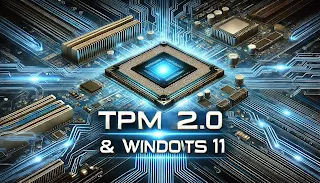
How to Bypass TPM 2.0 Requirements for Windows 11 Installation on Older PCs
Windows 11 introduces stricter hardware requirements, including TPM 2.0 (Trusted Platform Module) and Secure Boot. Many older but capable PCs are left out. This guide covers multiple methods to bypass these restrictions and install Windows 11 on unsupported hardware.
1. Understanding TPM 2.0 and Why Windows 11 Requires It
What is TPM 2.0?
TPM (Trusted Platform Module) is a hardware security feature that provides encryption and protects system integrity. Windows 11 mandates TPM 2.0 to enhance security against cyber threats.
Why Bypass TPM 2.0?
Many powerful older PCs lack TPM 2.0 or only support TPM 1.2, preventing them from upgrading to Windows 11. Fortunately, several workarounds exist.
2. Checking If Your PC Has TPM 2.0
Using Windows Security Settings:
- Press
Win + R, typetpm.msc, and pressEnter. - If TPM is available, you'll see its version (1.2 or 2.0).
Using Command Prompt:
- Open Command Prompt as Administrator.
- Type:
wmic /namespace:\\root\cimv2\Security\MicrosoftTpm path Win32_Tpm get SpecVersion - If you see
2.0, your system is compatible.
3. Method 1: Bypass TPM 2.0 Using Windows Registry
Steps:
- Boot from a Windows 11 installation USB/DVD.
- When you see the "This PC can't run Windows 11" message, press
Shift + F10to open Command Prompt. - Type
regeditand pressEnterto open the Registry Editor. - Navigate to:
HKEY_LOCAL_MACHINE\SYSTEM\Setup - Right-click Setup, select New > Key, and name it LabConfig.
- Inside LabConfig, create two new DWORD (32-bit) values:
BypassTPMCheck→ Set value to1BypassSecureBootCheck→ Set value to1
- Close Registry Editor and continue with installation.
4. Method 2: Create a Custom Windows 11 Bootable USB Without TPM Check
Requirements:
- A USB drive (8GB or more)
- Rufus (a free bootable USB creator)
Steps:
- Download the Windows 11 ISO from Microsoft.
- Open Rufus and insert your USB drive.
- Select the Windows 11 ISO file.
- Under Image option, select:
- "Extended Windows 11 Installation (No TPM / No Secure Boot / No RAM requirements)"
- Click Start and wait for the process to complete.
- Boot from the USB and install Windows 11.
5. Method 3: Modify the Windows 11 ISO File
Steps:
- Download and install AnyBurn or UltraISO.
- Open the Windows 11 ISO file.
- Navigate to
sourcesand delete the fileappraiserres.dll. - Save the modified ISO and create a bootable USB using Rufus.
- Boot from the USB and install Windows 11.
6. Method 4: Using a Windows 10 Installer to Install Windows 11
Steps:
- Create a Windows 10 bootable USB using the Media Creation Tool.
- Open the USB and go to the sources folder.
- Delete
install.wimorinstall.esd. - Extract the Windows 11 ISO and copy
install.wiminto the Windows 10 USB’s sources folder. - Boot from the USB and install Windows.
7. Post-Installation Considerations
Windows Updates: You may not receive automatic updates, but you can download them manually from the Microsoft Update Catalog.
System Stability & Security: Disabling TPM removes security features like BitLocker and Windows Hello, so use third-party antivirus software and back up data regularly.
Final Thoughts
Bypassing TPM 2.0 allows older PCs to run Windows 11, but it comes with potential risks. If your PC is unsupported but powerful enough, these methods will help you install and use the OS without issues.


إرسال تعليق